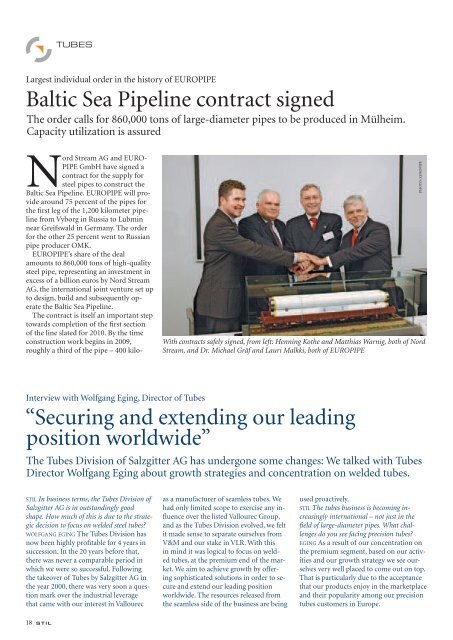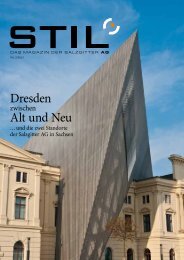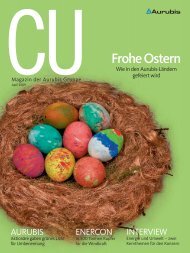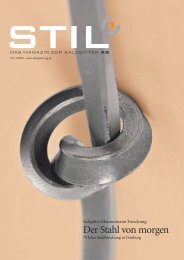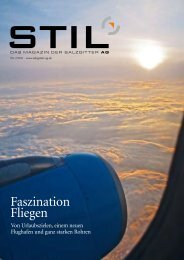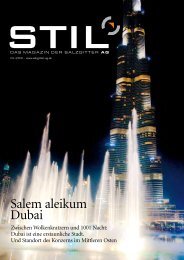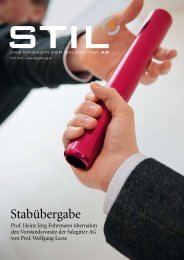Dr. Heinz Jörg Fuhrmann - Schau Verlag Hamburg
Dr. Heinz Jörg Fuhrmann - Schau Verlag Hamburg
Dr. Heinz Jörg Fuhrmann - Schau Verlag Hamburg
You also want an ePaper? Increase the reach of your titles
YUMPU automatically turns print PDFs into web optimized ePapers that Google loves.
tubes<br />
Largest individual order in the history of EUROPIPE<br />
Baltic Sea Pipeline contract signed<br />
The order calls for 860,000 tons of large-diameter pipes to be produced in Mülheim.<br />
Capacity utilization is assured<br />
Nord Stream AG and EURO-<br />
PIPE GmbH have signed a<br />
contract for the supply for<br />
steel pipes to construct the<br />
Baltic Sea Pipeline. EUROPIPE will provide<br />
around 75 percent of the pipes for<br />
the first leg of the 1,200 kilometer pipeline<br />
from Vyborg in Russia to Lubmin<br />
near Greifswald in Germany. The order<br />
for the other 25 percent went to Russian<br />
pipe producer OMK.<br />
EUROPIPE’s share of the deal<br />
amounts to 860,000 tons of high-quality<br />
steel pipe, representing an investment in<br />
excess of a billion euros by Nord Stream<br />
AG, the international joint venture set up<br />
to design, build and subsequently operate<br />
the Baltic Sea Pipeline.<br />
The contract is itself an important step<br />
towards completion of the first section<br />
of the line slated for 2010. By the time<br />
construction work begins in 2009,<br />
roughly a third of the pipe – 400 kilo-<br />
Interview with Wolfgang Eging, Director of Tubes<br />
With contracts safely signed, from left: Henning Kothe and Matthias Warnig, both of Nord<br />
Stream, and <strong>Dr</strong>. Michael Gräf and Lauri Malkki, both of EUROPIPE<br />
“Securing and extending our leading<br />
position worldwide”<br />
The Tubes Division of Salzgitter AG has undergone some changes: We talked with Tubes<br />
Director Wolfgang Eging about growth strategies and concentration on welded tubes.<br />
stil In business terms, the Tubes Division of<br />
Salzgitter AG is in outstandingly good<br />
shape. How much of this is due to the strategic<br />
decision to focus on welded steel tubes?<br />
wolfgang eging The Tubes Division has<br />
now been highly profitable for 4 years in<br />
succession. In the 20 years before that,<br />
there was never a comparable period in<br />
which we were so successful. Following<br />
the takeover of Tubes by Salzgitter AG in<br />
the year 2000, there was very soon a question<br />
mark over the industrial leverage<br />
that came with our interest in Vallourec<br />
as a manufacturer of seamless tubes. We<br />
had only limited scope to exercise any influence<br />
over the listed Vallourec Group,<br />
and as the Tubes Division evolved, we felt<br />
it made sense to separate ourselves from<br />
V&M and our stake in VLR. With this<br />
in mind it was logical to focus on welded<br />
tubes, at the premium end of the market.<br />
We aim to achieve growth by offering<br />
sophisticated solutions in order to secure<br />
and extend our leading position<br />
worldwide. The resources released from<br />
the seamless side of the business are being<br />
used proactively.<br />
stil The tubes business is becoming increasingly<br />
international – not just in the<br />
field of largediameter pipes. What challenges<br />
do you see facing precision tubes?<br />
eging As a result of our concentration on<br />
the premium segment, based on our activities<br />
and our growth strategy we see ourselves<br />
very well placed to come out on top.<br />
That is particularly due to the acceptance<br />
that our products enjoy in the marketplace<br />
and their popularity among our precision<br />
tubes customers in Europe.<br />
PHOTO: EUROPIPE<br />
meters – must be in store at various logistical<br />
depots, ready to be laid. Which<br />
means that by then the entire production<br />
chain must be completed, from steelmaking,<br />
plate rolling, tube manufacturing<br />
and coating through to transportation<br />
to the storage sites.<br />
The 860,000 tons of large-diameter<br />
pipe booked by EUROPIPE represent the<br />
largest single order in the company’s history.<br />
EUROPIPE will manufacture the entire<br />
order at its Mülheim works. The<br />
plate required to produce the pipes will<br />
be ordered by EUROPIPE from its shareholders<br />
Dillinger Hütte and Salzgitter.<br />
For Salzgitter’s part, the input material<br />
The pipeline will connect<br />
Russia and the European Union<br />
will be supplied from the plate mill at<br />
Mannesmannröhren Mülheim GmbH.<br />
This order alone represents capacity utilization<br />
in excess of 40 percent over 18<br />
months at EUROPIPE. The internal coating<br />
and external corrosion-proofing included<br />
in the order will be carried out by<br />
EUROPIPE’s subsidiary MÜLHEIM<br />
PIPECOATINGS (MPC) GmbH, which<br />
in turn will benefit from as much as<br />
60 percent capacity utilization.<br />
stil What role does the acquisition of manufacturers<br />
in France and the new company in<br />
Mexico have to play?<br />
eging By acquiring VPE and the plant in<br />
Zeithain producing input stock, we have<br />
laid the foundation on which to become<br />
Europe’s market leader. We intend to develop<br />
this position and use it to offer sophisticated<br />
solutions for our customers in the<br />
automotive and other industrial sectors.<br />
The acquisition in Mexico provides a<br />
nucleus for development outside of Europe.<br />
In future, we aim to secure a strong<br />
position for our automotive business in<br />
the NAFTA territories.<br />
stil The high prices for oil and gas are adding<br />
impetus to pipeline projects the world<br />
over. On the other hand, steel and tubes<br />
production is very energyintensive. At<br />
what point will this development become<br />
critical?<br />
eging Let’s think back to the 80’s and 90’s<br />
when an oil price of 30 US dollars a barrel<br />
was judged to be the balance point between<br />
exploration and the risk of under-<br />
The total cost of the Baltic Sea Pipeline<br />
will be in the order of six billion euros.<br />
That’s around 15 percent less than for an<br />
overland pipeline – including the operating<br />
costs for a 25-year period. This is due<br />
mainly to the comparatively high operating<br />
costs for a land-based pipeline and<br />
the associated compressor stations. The<br />
mining the development in gross<br />
national product.<br />
As we now know, this boundary<br />
has shifted with sustained effect.<br />
Worldwide demand for energy<br />
continues without a break and<br />
we have already reached an oil<br />
price of 100 US dollars a barrel.<br />
The demand for tubes for oil and<br />
gas exploration, transportation<br />
and energy generation is huge. Among the<br />
particular factors dictating this demand<br />
are the tremendous growth dynamics in<br />
the BRIC countries (Brazil, Russia, India<br />
and China) and the need to replace existing<br />
power stations.<br />
stil It has long since ceased to be enough<br />
just to make quality tubes – customers demand<br />
comprehensive service. What do we<br />
offer our customers?<br />
eging As a business model, simply manufacturing<br />
tubes is a thing of the past. We<br />
have been offering our customers far more<br />
for a long time now. We support them<br />
with customized solutions, from the initial<br />
pipeline will connect Russia and the European<br />
Union via the Baltic. EU demand<br />
for imports of natural gas is expected to<br />
reach 536 billion cubic meters by 2015 –<br />
compared with 336 billion in 2005. The<br />
Baltic Sea Gas Pipeline will be able to<br />
fulfill around 25 percent of the additional<br />
demand.<br />
The natural gas pipeline across the Baltic Sea<br />
Wolfgang Eging<br />
idea through to production. Our<br />
Trading Division, which is a global<br />
organization, and also the Group’s<br />
own research and product-based<br />
development facilities play an outstanding<br />
role. As a Group, we offer<br />
consultancy, production, supply,<br />
an international logistics network<br />
and other support functions,<br />
all from a single source.<br />
stil The companies that make up the Tubes<br />
Division have changed their names and<br />
logos. What were the reasons behind this?<br />
eging Our brand name is Salzgitter Mannesmann.<br />
What we are doing is combining the<br />
Mannesmann product name, which is recognized<br />
worldwide as a synonym for quality<br />
and competence in tubes, with the success<br />
story that is Salzgitter. For this reason, as has<br />
already happened at the Trading Division,<br />
we have prefixed all of our companies with<br />
the name “Salzgitter Mannesmann”. So both<br />
the Tubes and Trading Divisions now equally<br />
underscore the solidarity between Salzgitter<br />
and the synonym for tubes (Mannesmann).<br />
18 stil stil 19<br />
tubes<br />
Planned Nord<br />
StreamPipeline<br />
Planned service<br />
platform<br />
Pipeline of the<br />
European natural<br />
gas network<br />
Pipeline planned<br />
or in construction<br />
Territorial<br />
border


